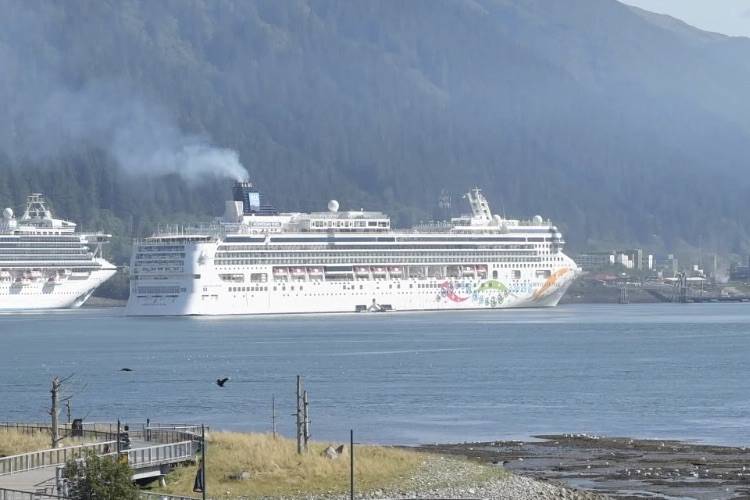As exhaust emissions poured from the Norwegian Pearl’s exhaust stack on Tuesday, so too did complaints to the Department of Environmental Conservation.
DEC received at least nine calls complaining about the ship’s emissions, and at least one more complaint was lodged electronically, according to Program Manager Ed White, who runs the Commercial Passenger Vessel Environmental Compliance program.
That number is “probably as high as any day that we’ve seen,” White told the Empire on Wednesday. White said he couldn’t comment on whether DEC was in the process of issuing a fine to the Norwegian Pearl as he’s not allowed to comment on ongoing compliance issues.
A 45-minute video of the docking was captured by the Empire and compressed into a video time lapse. The footage, taken from the Douglas Bridge, shows the Pearl emitting nearly-opaque exhaust for much of the video.
The Pearl began to dock at about 1:30 p.m. Tuesday, maneuvering into position at the AJ Dock after the Norwegian Bliss, which left the dock around this time.
Complaints to DEC were made around the time of the Pearl’s docking, but White said he can’t be positive they all identified the same ship. He and his staff are still processing complaints.
Cruise ships can incur hefty fines for violating DEC air quality regulations. DEC handed out two violations last year to cruise ships, the Norwegian Jewel and the Amsterdam, which were both cited in Ketchikan. Those violations can be as high as $46,192, a fine which was raised this year from $37,500.
No air quality violations have been issued yet this year, but fines are typically levied at the end of the year, White said. The fine process takes a little longer for air quality compared to wastewater discharge violations, which are based on self-monitoring and are often issued a day or two after the violation.
Following Environmental Protection Agency guidelines, air quality violations are based on percentage of opacity, where 0 percent means emissions are seethrough, while 100 percent opacity means one can’t see through it.
Monitors grade these emissions in Juneau and other Alaska cruise ship ports.
Ships are allowed to exceed 20 percent opacity for three minutes an hour while at the dock. When casting off, anchoring and docking, ship exhausts are only allowed to exceed 40 percent opacity for nine minutes out of an hour.
Emissions monitors were out monitoring emissions on Tuesday, White said, but he hasn’t yet received a report of any violation from the Pearl. That could take a few days.
DEC did contact the Norwegian Pearl to let them know of the increase in calls.
New sulfur scrubbers being employed this year have changed how monitors assess air quality, White added, something DEC is still trying to get used to.
White and his three-person staff field calls from locals concerned about how cruise ships are affecting air and water quality. The staff is still logging complaints made over the Labor Day weekend, but as of the beginning of the month, they’d received 112 complaints so far this year.
In 2008, White said DEC received 50 complaints in one day for a ship that wasn’t on the cruise ship calendar and wasn’t expected in town. That was an “extraordinary situation,” he said, which he wouldn’t compare to Tuesday. That ship did receive a penalty.
Complaint totals have been as low as zero (2016) and over 100, White said.
“In a typical year, we’ll receive a few (calls) a week maybe at most. Yesterday exceeded the amount of calls that were received in 2015,” White said.
• Contact reporter Kevin Gullufsen at 523-2228 and kgullufsen@juneauempire.com. Follow him on Twitter at @KevinGullufsen.

